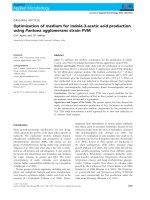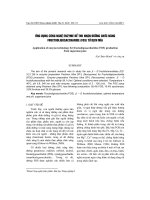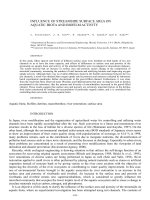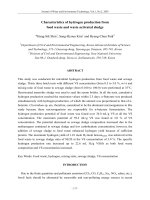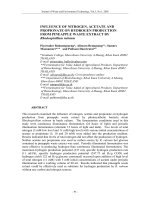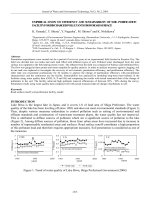PRE book 090901 surface production operations VOLUME1 2e
Bạn đang xem bản rút gọn của tài liệu. Xem và tải ngay bản đầy đủ của tài liệu tại đây (12.44 MB, 462 trang )
(Surface Production Operations)
DISCLAIMER
This text contains descriptions, statements, equations, procedures,
methodology, interpretations, and other written matter and information,
hereinafter collectively called "contents," that have been carefully considered and prepared as a matter of general information. The contents are
believed to reliably represent situations and conditions that have occurred or
could occur, but are not represented or guaranteed as to the accuracy or
application to other conditions or situations. There are many variable conditions in production facility design and related situations, and the authors
have no knowledge or control of their interpretation. Therefore, the contents
and all interpretations and recommendations made in connection herewith
are presented solely as a guide for the user's consideration, investigation,
and verification. No warranties of any kind, whether expressed or implied,
are made in connection therewith. The user is specifically cautioned,
reminded, and advTised that any use or interpretation of the contents and
resulting use or application thereof are made at the sole risk of the user. In
production facility design there are many proprietary designs and techniques. We have tried to show designs and techniques in a generic nature
where possible. The user must assure himself that in actual situations it is
appropriate to use this generic approach. If the actual situation differs from
the generic situation in design or lies outside the bounds of assumptions
used in the various equations, the user must modify the information contained herein accordingly.
In consideration of these premises, any user of the contents agrees to
indemnify and hold harmless the authors and publisher from all claims and
actions for loss, damages, death, or injury to persons or property.
I
Surface Production Operations
Design of Oil-Handling
Systems and Facilities
Ken Arnold
Maurice Stewart
SECOND EDITION
Surface Production Operations
VOLUME 1
Design of Oil-Handling
Systems and Facilities
Copyright © 1989, 1999 by Butterworth-Heinemann. All
rights reserved. Printed in the United States of America. This
book, or parts thereof, may not be reproduced in any form
without permission of the publisher.
Originally published by Gulf Publishing Company,
Houston, TX.
For information, please contact:
Manager of Special Sales
Butterworth-Heinemann
225 Wildwood Avenue
Woburn, MA 01801-2041
Tel: 781-904-2500
Fax: 781-904-2620
For information on all Butterworth-Heinemann publications
available, contact our World Wide Web home page at:
10 9
8 7
6
5 4
Library of Congress Cataloging-in-Publication Data
Arnold, Ken, 1942Design of oil-handling systems and facilities / Ken Arnold, Maurice
Stewart. — 2nd ed.
p. cm. — (Surface production operations; v. 1)
Includes index.
ISBN 0-88415-821-7 (alk. paper)
1. Petroleum engineering—Equipment and supplies. 2. Oil
fields—Equipment and supplies. 3. Oil fields—Production methods.
I. Stewart, Maurice. II. Title. III. Series.
TN871.5.A74 1998
665.5—dc21
97-38110
CIP
Printed in the United States of America.
Printed on acid-free paper (°o).
iv
Contents
Acknowledgments
xi
Preface
xiii
CHAPTER 1
The Production Facility •
1
Introduction, 1
Making the Equipment Work, 16
Facility Types, 18
CHAPTER 2
Choosing a Process
26
Introduction, 26
Controlling the Process, 26
Operation of a Control Valve 26, Pressure Control 29,
Level Control 30, Temperature Control 30, Flow Control 31
Basic System Configuration, 31
Wellhead and Manifold 31, Separation 31, Oil Treating 38,
Lease Automatic Custody Transfer (LACT) 40, Pumps 42,
Water Treating 43, Compressors 43, Gas Dehydrators 46
Well Testing, 48
Gas Lift, 51
Offshore Platform Considerations, 54
Overview 54, Modular Construction 55,
Equipment Arrangement 55
CHAPTER 3
Fluid Properties
58
Introduction, 58
Basic Principles, 58
Specific Gravity and Density 58, Viscosity 64
v
Flash Calculations, 69
Characterizing the Flow Stream, 87
Molecular Weight of Gas 87, Gas Flow Rate 88,
Liquid Molecular Weight 89, Specific Gravity of
Liquid 90, Liquid Flow Rate 92, The Flow Stream 92
Approximate Flash Calculations, 93
Other Properties, 95
CHAPTER 4
Two-Phase Oil and Gas Separation
101
Introduction, 101
Factors Affecting Separation, 102
Equipment Description, 102
Horizontal Separators 102, Vertical Separators 104,
Spherical Separators 104, Other Configurations 105,
Scrubbers 107
Horizontal vs. Vertical Vessel Selection, 108
Vessel Internals, 109
Inlet Diverters 109, Wave Breakers 111, Defoaming Plates 111,
Vortex Breaker 112, Mist Extractor 112
Potential Operating Problems, 115
Foamy Crudes 115, Paraffin 116, Sand 117,
Liquid Carryover and Gas Blowby 117
Theory, 117
Settling 117, Drop Size 121, Retention Time 122,
Re-entrainment 122
Separator Sizing, 122
Horizontal Separators 122, Procedure for Sizing Horizontal
Separators 126, Vertical Separators 126
Examples, 129
Sizing a Vertical Separator 129,
Sizing a Horizontal Separator 133
References, 134
CHAPTER 5
Oil and Water Separation
135
Introduction, 135
Equipment Description, 136
Horizontal Separators 136, Vertical Separators 140,
Horizontal vs. Vertical Selection 142
vi
Vessel Internals, 143
Coalescing Plates 143, Sand Jets and Drains 143
Emulsions, 144
Theory, 144
Gas Separation 144, Oil/Water Settling 144,
Water Droplet Size in Oil 144, Oil Droplet Size in Water 145,
Retention Time 145
Separator Sizing, 145
Horizontal Separators 146, Settling Equation 148,
Vertical Separators 151
Examples, 154
Sizing a Vertical Three-Phase Separator 154,
Sizing a Horizontal Three-Phase Separator 156
CHAPTER 6
Crude Oil Treating Systems
160
Introduction, 160
Emulsion Treating Theory, 161
Forming Emulsions 161, Emulsifying Agent 164,
Demulsifiers 165
Gravity Separation, 167
Coalescence 168, Viscosity 169, Temperature Effects 170,
Heat Input Equations 174, Water Droplet Size and Retention
Time 175, Coalescing Media 175, Electrostatic Coalescers 176
Treating Equipment, 177
Vertical Treaters 177, Horizontal Treaters 180,
Electrostatic Treaters 181
Equipment Sizing and Theory, 182
Settling Equations 182, Retention Time Equations 184,
Water Droplet Size 185
Design Procedure, 188
Examples, 189
Sizing a Horizontal Treater 189, Sizing a Vertical Treater 191
References, 192
CHAPTER 7
Produced-Water Treating Systems
Introduction, 194
System Description, 195
vii
194
Theory, 197
Gravity Separation 197, Dispersion 198, Coalescence 198,
Flotation 199
Treating Equipment, 199
Settling Tanks and Skimmer Vessels 199,
Skimmer Sizing Equations 202, Plate Coalescers 207,
Skimmer/Coalescers 214, Precipitators/Coalescing Filters 215,
Free-Flow Turbulent Coalescers (SP Packs) 215,
Flotation Units 218, Hydrocyclones 223, Disposal Piles 225,
Skim Pile 228
Drain Systems, 230
Information Required for Design, 230
Influent Water Quality, 231
Produced Water 231, Soluble Oil 232, Deck Drainage 233
Equipment Selection Procedure, 233
Equipment Specification, 236
Example: Design the Produced-Water Treating System for the
Data Given, 237
CHAPTER 8
Pressure Drop in Piping
Introduction, 244
Basic Principles, 245
Reynolds Number 245, Flow Regimes 247,
Bernoulli's Theorem 247, Darcy's Equation 248,
Moody Friction Factor 249
Fluid Flow Equations, 251
Liquid Flow 251, Gas Flow 254, Two-Phase Flow 263
Head Loss in Valves and Pipe Fittings, 273
Resistance Coefficients 274, Flow Coefficient 274,
Equivalent Length 277, Laminar Flow Coefficient 278
Example Pressure Drop Calculations, 278
Pressure Drop in Liquid Line 278,
Pressure Drop in Gas Line 281,
Pressure Drop in Two-Phase Line 284
244
CHAPTER 9
Choosing a Line Size and Wall Thickness
Introduction, 285
viii
285
Line Size Criteria, 286
Erosional Flow 286, Liquid Lines 289, Gas Lines 291,
Two-Phase Flow 295
Wall Thickness Criteria, 299
Standards and Requirements 299, General Hoop Stress
Formula for Thin Wall Cylinders 300
Pressure Rating Classes, 313
Industry Standards 313, API 6A 314,
Pipe, Valve, and Fitting Specifications 314
Examples, 324
Liquid Line 324, Gas Line 329, Two-Phase Line 330
References, 332
CHAPTER 1O
Pumps
Introduction, 333
Pump Classification, 333
Centrifugal Pumps, 334
Reciprocating Pumps, 339
Diaphragm Pumps, 344
Rotary Pumps, 345
Multiphase Pumps, 347
Basic Principles, 347
Head 347, Horsepower 349,
Net Positive Suction Head (NPSH) 350
Basic Selection Criteria, 352
333
CHAPTER 11
Centrifugal Pumps
Introduction, 355
Multiple Pump Installations, 356
Pump Specific Speed, 358
Codes and Standards, 358
Generic Types of Centrifugal Pumps, 359
ANSI Pump 359, Single-Stage API Pump 361,
Vertical In-Line Pump 362, API Multistage Split
Case Pump 364, API Barrel Pumps 364, Sump Pump 365,
ix
355
API Vertical Turbine or Can Pump 366,
Submersible Pump 367
Bearings, Seals, and Wear Rings, 368
Bearings 368, Seals 369, Wear Rings 372
Installation Considerations, 373
CHAPTER 12
Reciprocating Pumps
376
Introduction, 376
Controlling Pulsating Flow, 377
Suction and Discharge Piping 377, Pulsation Dampeners 377,
Pipe Vibrations 384
Bearings, Valves, and Packing, 387
Codes and Standards, 387
Piping Hookup, 391
Operation, 392
Bypass Valve 392, Variable-Speed Motors and Drivers 392
CHAPTER 13
Organizing the Project
Introduction, 394
Project Steps, 395
Project Initiation 395, Conceptual Study 395,
Project Definition 399, Design Engineering 406,
Detailed Engineering 409, Procurement 412,
Inspection and Expediting 417, Startup 418, Dossier 419
Project Control and Execution Format, 419
Project Control, 419
Engineering Control 419, Project Cost Control 426,
Project Timing Control 427
Project Execution Format, 428
Turnkey 428, Negotiated Turnkey 429,
Modified Turnkey 430, Cost-Pius 431,
Comparison of Formats 432
394
APPENDIX A
Sample Project Assignment
434
Index
437
x
Acknowledgments
It was Maurice Stewart's idea to take the lecture notes that I had developed for my course at the University of Houston, add some material he
developed for his lecture notes at Tulane University, and write this book.
In addition, Maurice was responsible for first drafts of several chapters,
editorial review, and comment on the finished work, and he aided greatly
in developing many of the illustrations.
There are two core themes to my lecture notes and this book: (1) engineers must be aware of the first principle basis for their design procedures if they are to exercise the correct judgment in choosing between
alternatives, and (2) the mystery of process vessel design can be removed
and design equations unified using a drop size distribution and analysis
technique that others have developed before me and I merely extended to
other situations.
I am indebted to professors Robert McGuire and Richard White of
Cornell University for convincing an impressionable undergraduate of
the importance of the first theme. With this understanding I have spent
much of my working life trying to explain observed phenomena and published answers in the field of production facility design. In this effort I
have been fortunate to have worked for two of the best companies in their
respective industries, Shell Oil Company and Paragon Engineering Services, Inc. Both have given me the opportunity and resources to continue
to pursue this goal and apply the ideas and concepts presented in this
book to real situations.
I am indebted to several colleagues within both Paragon and Shell who
have aided, instructed, critiqued, and provided me with hours of argument.
For the second edition, I would like to thank the following Paragon
engineers who each revised a chapter: Eric Barron, Jim Cullen, Fernando
De La Fuente, Robert Ferguson, Mike Hale, Sandeep Khurana, Kevin
xi
Mara, Matt McKinstry, Carl Sikes, Mary Thro, Kirk Trascher, and Mike
Whitworth. I would also like to thank David Arnold for pulling it all
together at the end.
Ken Arnold, RE.
Houston, Texas
A special debt of gratitude is extended to the numerous colleagues
throughout industry who have directly contributed to the initial preparation of this text and this revision by their suggestions and criticisms. A
few select words are inadequate to describe their help. I am especially
indebted to the following: Jamin Djuang of PT Loka Datamas Indah;
Chang Choon Kiang, Ridzuan Affrin, and Amran Manaf of Dexcel Sdn.
Bhd; Hidayat Maruta and Ridwan Chandra of PT Caltex Pacific Indonesia; Lukman Manfoedz and Holland Simanjuntak of VICO Indonesia;
Suhariyadi Suharwan of Maxus Indonesia; Bambang Indrawan of Gas
Services International Limited; Andy Boyo and Clem Nwogbo of ABNL
Nigeria; Gary Hagstrom, Gary Fhur, and Roger Van Gelder of Chevron
Nigeria Limited; Stan Evans of Mobil Producing Nigeria Unlimited;
Mike Zimmerman and Jeff Post of CABGOC Angola; and Dave Cunninghan of COPI and Bruce Lowerly of John H. Carter Company.
I would also like to thank my students at Louisiana State University
and more than 29,000 professionals in 63 countries who have attended
my SPE short courses, public seminars, and in-house workshops. I am
indebted to these professionals for their suggestions concerning oversights, inconsistencies, and changes in text format.
Finally, I would like to express a special thanks to and dedicate this
text to my son, Chad, who deserved more than a part-time father during
the preparation of this text.
Maurice I. Stewart, Ph.D., P.E.
Baton Rouge, Louisiana
xii
Preface
As teachers of production facility design courses in petroleum engineering programs, we both realized there was no single source that could
be used as a text in this field. We found ourselves reproducing pages
from catalogues, reports, projects we had done, etc., to provide our students with the basic information they needed to understand the lectures
and carry out their assignments. Of more importance, the material that
did exist usually contained nomographs, charts, and rules of thumb that
had no reference to the basic theories and underlying assumptions upon
which they were based or, worse, had misleading or even false statements
concerning these principles.
This text, which covers about one semester's work, presents the basic
concepts and techniques necessary to design, specify, and manage oil
field surface production facilities. It provides a clear understanding of the
equipment and processes used in common separation and oil and water
treating systems, as well as the selection of piping and pumping systems.
We hope this will enable you to develop a "feel" for the important parameters of designing and operating a production facility. We also wish the
reader to understand the uncertainties and assumptions inherent in
designing and using the equipment in these systems and the limitations,
advantages, and disadvantages associated with their use.
We strongly believe that there is an engineering discipline and science
to production facility design. If someone is going to be taught to apply
this science intelligently, the underlying assumptions and the engineering
discipline must be understood. In developing our lecture notes we structured them around derivations of design equations from first principles so
that our students could see the assumptions that were made and their
importance. Wherever a rule of thumb must be applied, we have attempted to explain at least qualitatively why it was reasonable and under what
conditions it might be altered. Some of the material is by necessity presented as nothing more than an educated guess to be used only if no other
xiii
information in the form of laboratory studies or field experience exists.
These points are clearly stated in the text. It is hoped that by publishing
these thoughts we will stimulate others to publish their experiences and
rules of thumb, and help stimulate some much-needed research.
Some of our students have no background in production facility design
other than what they have learned in the introductory petroleum engineering courses. For this reason, we have found by trial and error that it
is best to start with an overview explaining the goals of the facility with
pictures of the equipment. We then discuss how the equipment is put
together into a process system before explaining process calculations and
equipment designing procedures. We have experimented with discussing
the process system at the end of the course, but have found that the interrelationship of the various pieces of equipment confuses the student.
Therefore, while there is some repetition caused by the order of the chapters, experience shows us that, in the final analysis, the present order provides the student with a clearer understanding of the concepts.
The order chosen for the book has the side benefit of allowing the
instructor to assign a project at the start of the course and have the student take it another step forward as each segment is completed. An example project is included in Appendix A. As there are many correct answers
in facility process and equipment design, no two projects will be identical, but the student should be able to defend his selection. One of us ends
the semester by having each student defend his project in an oral presentation.
The more experienced design engineer may wish to just skim the first
three chapters. We have tried to make this an easier reference book to use
by visually separating the derivations from the rest of the text so that the
design equations and important assumptions stand out more clearly.
Where needed, we have summarized each section with a design procedure or an example calculation.
This volume focuses on areas that primarily concern oil-handling facilities. These topics are not adequately addressed in the literature, and handling oil and water is much more of an art and less of a science than handling gas. The book does not cover gas dehydration and treating, gas
compression, electric generators and distribution, material selection and
corrosion control, chemical treatment, welding, water purification and
steam generation equipment, instrument specification and system design,
xiv
foundations, platforms, buildings, and many other topics that fall under
the responsibility of a surface facility or construction engineer.
The final chapter on project management may appear a little out of
place. However, it is our experience that a large part of the production
facility engineer's job is project management. It would be a shame if the
students taking our course eventually became managers of production
facility engineers and were never exposed to the concepts contained in
this chapter. One of the most common comments we hear from engineers
in this field is that the petroleum engineers who supervise them have no
concept of the problems associated with managing one of these projects.
Throughout the book we have attempted to concentrate on what we
perceive to be modern and common practices. Although we have either
personally been involved in the design of facilities all over the world or
have people in our organizations who have done so, undoubtedly we are
influenced by our own experience and prejudices. We apologize if we
have left something out or have expressed opinions on equipment types
that differ from your experiences. We have learned much from our students' comments on such matters and would appreciate receiving yours
for future revisions/editions.
Ken Arnold, RE.
Houston, Texas
Maurice I. Stewart, Ph.D., RE.
Baton Rouge, Louisiana
This page intentionally left blank
(Surface Production Operations)
This page intentionally left blank
CHAPTER
1
The Production
Facility
INTRODUCTION
The job of a production facility is to separate the well stream into three
components, typically called "phases" (oil, gas, and water), and process
these phases into some marketable product(s) or dispose of them in an environmentally acceptable manner. In mechanical devices called "separators"
gas is flashed from the liquids and "free water" is separated from the oil.
These steps remove enough light hydrocarbons to produce a stable crude oil
with the volatility (vapor pressure) to meet sales criteria. Figures 1-1 and 12 show typical separators used to separate gas from liquid or water from oil.
Separators can be either horizontal or vertical in configuration.
The gas that is separated must be compressed and treated for sales.
Compression is typically done by engine-driven reciprocating compressors, Figure 1-3. In large facilities or in booster service, turbine-driven
centrifugal compressors, such as that shown in Figure 1-4, are used.
Large integral reciprocating compressors are also used, Figure 1-5.
Usually, the separated gas is saturated with water vapor and must be
dehydrated to an acceptable level (normally less than 7 Ib/MMscf). Usually this is done in a glycol dehydrator, such as that shown in Figure 1-6.
(text continued on page 4)
1
2
Design of OIL-HANDLING Systems and Facilities
Figure 1 -1. A typical vertical twophase separator at a land location.
The inlet comes in the left side/ gas
comes off the top, and liquid leaves
the bottom right side of the
separator.
Figure 1 -2. A typical horizontal separator on an offshore platform showing the
inlet side. Note the drain valves at various points along the bottom and the access
platform along the top.
The Production Facility
3
Figure 1 -3. An engine-driven compressor package. The inlet and interstage
scrubbers (separators) are at the right. The gas is routed through pulsation bottles
to gas cylinders and then to the cooler on the left end of the package. The engine
that drives the compressor cylinders is located to the right of the box-like coofer.
Figure 1 -4. A turbine-driven centrifugal compressor. The turbine draws air in from
the large duct on the left. This is mixed with fuel and ignited. The jet of gas thus
created causes the turbine blades to turn at high speed before being exhausted
vertically upward through the large cylindricalduct. The turbine shaft drives the
two centrifugal compressors, which are located behind the control cabinets on the
right end of the skia.
4
Design of OIL-HANDLING Systems and Facilities
Figure 1 -5. A 5500-hp integral reciprocating compressor. The sixteen power
cylinders located at the top of the unit (eight on each side) drive a crankshaft that
is directly coupled to the horizontal compressor cylinders facing the camera. Large
cylindrical "bottles" mounted above ana below the compressor cylinders filter out
acoustical pulsations in the gas being compressed.
(text continued from page 1)
Dry glycol is pumped to the large vertical contact tower where it strips
the gas of its water vapor. The wet glycol then flows through a separator
to the large horizontal reboiler where it is heated and the water boiled off
as steam.
In some locations it may be necessary to remove the heavier hydrocarbons to lower the hydrocarbon dew point. Contaminants such as H2S and
CO2 may be present at levels higher than those acceptable to the gas purchaser. If this is the case, then additional equipment will be necessary to
"sweeten" the gas.
The oil and emulsion from the separators must be treated to remove
water. Most oil contracts specify a maximum percent of basic sediment
and water (BS and W) that can be in the crude. This will typically vary
from 0.5% to 3% depending on location. Some refineries have a limit on
salt content in the crude, which may require several stages of dilution
with fresh water and subsequent treating to remove the water. Typical salt
limits are 10 to 25 pounds of salt per thousand barrels.
The Production Facility
5
Figure 1 -6. A small glycol gas
dehydration system, me large
vertical vessel on the left is the
contact tower where "dry"
glycol contacts the gas and
absorbs water vapor. The upper
horizontal vessel is the
"reboiler" or "reconcentrator"
where the wet glycol is heated,
boiling off the water that exits
the vertical pipe coming off the
top just behind the contact
tower. The lower horizontal
vessel serves as a surge tank.
Figures 1-7 and 1-8 are typical direct-fired heater-treaters that are used
for removing water from the oil and emulsion being treated. These can be
either horizontal or vertical in configuration and are distinguished by the
fire tube, air intakes, and exhausts that are clearly visible. Treaters can be
built without fire tubes, which makes them look very much like separators. Oil treating can also be done by settling or in gunbarrel tanks, which
have either external or internal gas boots. A gunbarrel tank with an internal gas boot is shown in Figure 1-9.
Production facilities must also accommodate accurate measuring and
sampling of the crude oil. This can be done automatically with a Lease
Automatic Custody Transfer (LACT) unit or by gauging in a calibrated
tank. Figure 1-10 shows a typical LACT unit.
The water that is produced with crude oil can be disposed of overboard
in most offshore areas, or evaporated from pits in some locations
onshore. Usually, it is injected into disposal wells or used for waterflooding. In any case, water from the separators must be treated to remove
small quantities of produced oil. If the water is to be injected into a disposal well, facilities may be required to filter solid particles from it.
(text continued on page 8)
6
Design of OIL-HANDLING Systems and Facilities
Figure 1 -7. A vertical heater treater. The emulsion to be treated enters on the far
side. The fire tubes (facing the camera) heat the emulsion, and oil exits near the
top. Water exits the bottom through the external water leg on the right, which
maintains the proper height of the interface between oil and water in the vessel.
Gas exits the top. Some of the gas goes to the small "pot" at the lower right where
it is scrubbed prior to being used for fuel for the burners.
Figure 1 -8. A horizontal heater treater with two burners.

